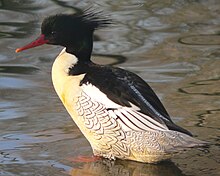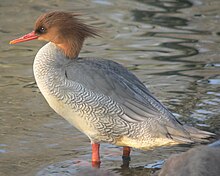
The Changbai Mountains are a major mountain range in Northeast Asia that extends from the Northeast Chinese provinces of Heilongjiang, Jilin and Liaoning, across the China-North Korea border, to the North Korean provinces of Ryanggang and Chagang. They are also referred to as the Šanggiyan Mountains in the Manchu language, or the Great Paekdu in Korean. Most of its peaks exceed 2,000 m (6,600 ft) in height, with the tallest summit being Paektu Mountain at 2,744 m (9,003 ft), which contains the Heaven Lake, the highest volcanic crater lake in the world at an surface elevation of 2,189.1 m (7,182 ft). The protected area Longwanqun National Forest Park is located within the vicinity of the mountain range.
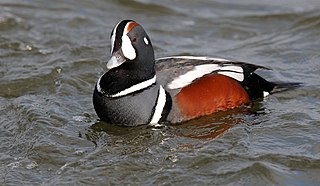
The sea ducks (Mergini) are a tribe of the duck subfamily of birds, the Anatinae. The taxonomy of this group is incomplete. Some authorities separate the group as a subfamily, while others remove some genera. Most species within the group spend their winters near coastal waters. Many species have developed specialized salt glands to allow them to tolerate salt water, but these are poorly developed in juveniles. Some of the species prefer riverine habitats. All but two of the 22 species in this group live in far northern latitudes.
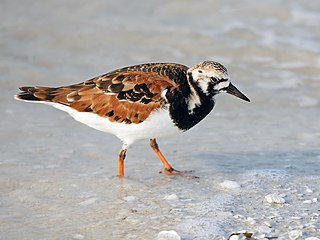
The ruddy turnstone is a small cosmopolitan wading bird, one of two species of turnstone in the genus Arenaria.

The hooded merganser is a species of fish-eating duck in the subfamily Anatinae. It is the only extant species in the genus Lophodytes. The genus name derives from the Greek language: lophos meaning 'crest', and dutes meaning 'diver'. The bird is striking in appearance; both sexes have crests that they can raise or lower, and the breeding plumage of the male is handsomely patterned and coloured. The hooded merganser has a sawbill but is not classified as a typical merganser.

The common merganser or goosander (Eurasian) is a large sea duck of rivers and lakes in forested areas of Europe, Asia, and North America. The common merganser eats mainly fish. It nests in holes in trees.

The red-breasted merganser is a duck species that is native to much of the Northern Hemisphere. The red breast that gives the species its common name is only displayed by males in breeding plumage. Individuals fly rapidly, and feed by diving from the surface to pursue aquatic animals underwater, using serrated bills to capture slippery fish. They migrate each year from breeding sites on lakes and rivers to their mostly coastal wintering areas, making them the only species in the genus Mergus to frequent saltwater. They form flocks outside of breeding season that are usually small but can reach 100 individuals. The worldwide population of this species is stable, though it is threatened in some areas by habitat loss and other factors.

Mergus is the genus of the typical mergansers fish-eating ducks in the subfamily Anatinae. The genus name is a Latin word used by Pliny the Elder and other Roman authors to refer to an unspecified waterbird.

The Dalmatian pelican is the largest member of the pelican family, and perhaps the world's largest freshwater bird, although rivaled in weight and length by the largest swans. They are elegant soaring birds, with wingspans rivaling those of the great albatrosses, and their flocks fly in graceful synchrony. With a range spanning across much of Central Eurasia, from the Mediterranean in the West to the Taiwan Strait in the East, and from the Persian Gulf in the South to Siberia in the North, it is a short-to-medium-distance migrant between breeding and overwintering areas. No subspecies are known to exist over its wide range, but based on size differences, a Pleistocene paleosubspecies, P. c. palaeocrispus, has been described from fossils recovered at Binagady, Azerbaijan.
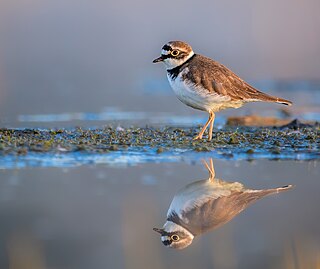
The little ringed plover is a small plover. The genus name Charadrius is a Late Latin word for a yellowish bird mentioned in the fourth-century Vulgate. It derives from Ancient Greek kharadrios a bird found in river valleys. The specific dubius is Latin for doubtful, since Sonnerat, writing in 1776, thought this bird might be just a variant of common ringed plover.
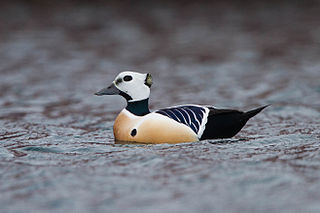
Steller's eider is a migrating Arctic diving duck that breeds along the coastlines of eastern Russia and Alaska. It is the rarest, smallest, and fastest flying of the eider species.
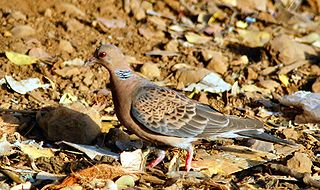
The Oriental turtle dove or rufous turtle dove is a member of the bird family Columbidae. The species has a wide native distribution range from Central Asia east across Asia to Japan. The populations show variations in the patterning of plumage and have been designated into at least six named subspecies. Populations in the higher latitudes tend to migrate south in winter, while those closer to the tropics are sedentary. Vagrants have been recorded in North America. The species is predominantly granivorous and forages on the ground.

The red-crowned crane, also called the Manchurian crane or Japanese crane, is a large East Asian crane among the rarest cranes in the world. In some parts of its range, it is known as a symbol of luck, longevity, and fidelity.

The Brazilian merganser is a South American diving duck in the Mergus genus. It is one of the most threatened waterfowl species in the world, with possibly fewer than 250 birds in the wild and a small number kept in captivity in Brazil. It has a long, sharp-edged beak with a great number of tooth-like edges.

Baer's pochard is a diving duck found in eastern Asia. It is a resident bird in North and Central China, and formerly bred in southeast Russia and Northeast China, migrating in winter to southern China, Vietnam, Japan, and India. Baer's pochard is a monotypic species. The holotype was collected in middle Amur.
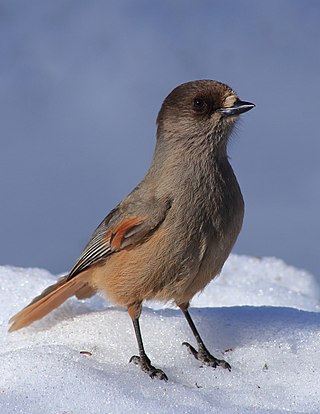
The Siberian jay is a small jay with a widespread distribution within the coniferous forests in North Eurasia. It has grey-brown plumage with a darker brown crown and a paler throat. It is rusty-red in a panel near the wing-bend, on the undertail coverts and on the sides of the tail. The sexes are similar. Although its habitat is being fragmented, it is a common bird with a very wide range so the International Union for Conservation of Nature has assessed its conservation status as being of "least concern".

The fairy pitta is a small and brightly colored species of passerine bird in the family Pittidae. Its diet mainly consists of earthworms, spiders, insects, slugs, and snails. The fairy pitta breeds in East Asia and migrates south to winter in Southeast Asia. Due to various habitat and anthropogenic disruptions, such as deforestation, wildfire, hunting, trapping, and cage-bird trade, the fairy pitta is rare and the population is declining in most places. Listed on the Convention on International Trade in Endangered Species of Wild Fauna and Flora (CITES) Appendix II, this bird is classified as vulnerable on the IUCN Red List of Threatened Species.

The long-billed plover is a species of wading bird in the family Charadriidae. It can be found in Bangladesh, Bhutan, Brunei, Cambodia, China, Hong Kong, India, Indonesia, Japan, Laos, Malaysia, Mongolia, Myanmar, Nepal, North Korea, Russia, South Korea, Sri Lanka, Taiwan, Thailand, and Vietnam. The long-billed plover is a migratory bird, so it breeds and spends the winter in different parts of its range. This bird can often be spotted along the shores of rivers, streams, in wetlands, and rice fields. It forages on the shoreline primarily for aquatic insects, insect larvae, and other invertebrates. It is difficult to distinguish between male and female individuals because of their similar plumage. The breeding season starts at the end of February or early March and ends in July. A male and a female forms a monogamous pair and maintains their territory throughout the breeding season. A global population survey in 2016 assessed the long-billed plover as a species of least concern on the International Union for Conservation of Nature (IUCN) Red List.

Located in Coos County, New Hampshire and Oxford County, Maine, Umbagog National Wildlife Refuge is a northern treasure in the National Wildlife Refuge System. The diversity of exceptional habitats provides excellent breeding and foraging areas for migratory birds, endangered species, resident wildlife, and rare plants. The refuge protects over 25,650 acres (103.8 km2) of wetland and forested upland habitat along Umbagog Lake. About 70% of its area is in New Hampshire and 30% in Maine.

The Xin River flows in Yushan County from the eastern edge of Jiangxi Province of central China into Poyang Lake. Some Wikipedia maps appear to call this the Xiao River.
